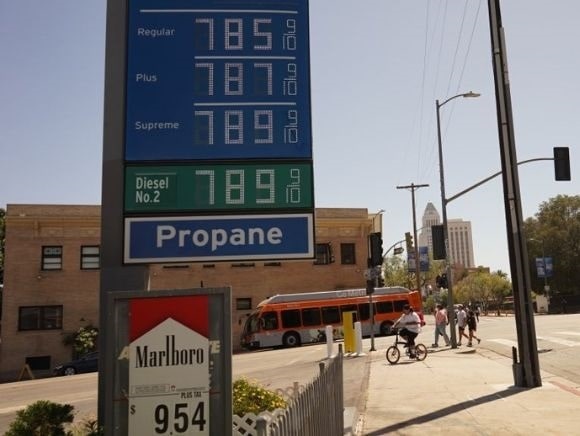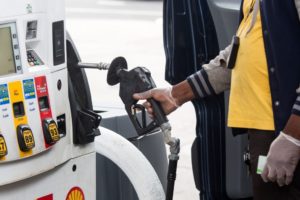
(Photo by Zeng Hui/Xinhua via Getty Images)
The national average price for a gallon of gasoline is again breaking record numbers. Gas prices are soaring so much that drivers may end upt borrowing against their automobiles to fill up their tanks. Americans are paying $4.92, with several states enduring a sticker shock north of $5 and even $6, according to the American Automobile Association (AAA). Diesel is not offering any relief to motorists, either, with the national average topping $5.64 per gallon. But what is going on in the economy when gasoline surges nearly 60% from last year and even more than 5% from a week ago?
The Dollars and Cents of Energy Prices
A barrel of West Texas Intermediate (WTI) crude oil is back at around $120, despite President Joe Biden throwing everything at the energy crisis, be it tapping domestic reserves or encouraging the nation to buy electric vehicles. The problem is simple: Supply and output are failing to keep up with demand. Although prices continue to increase, people are refraining from altering their habits. In economics, this would be a case of inelastic demand: Consumption of goods or services is unchanged even when prices advance.
Shrinking US stockpiles have many market observers warning that the pain at the pump will linger a lot longer than anticipated. Last week, total domestic gasoline inventories fell by 700,000 barrels to 219 million barrels, while demand rose to 8.98 million barrels per day.
“People are still fueling up, despite these high prices,” said Andrew Gross, AAA spokesperson. “At some point, drivers may change their daily driving habits or lifestyle due to these high prices, but we are not there yet.”
Will the United States ever get there? For one thing, consumers certainly believe that gas prices have a long way to go before they ease. A recent Liberty Nation poll found that 60% of respondents expect the average national price per gallon this summer will surpass $6, while fewer than one-third think it will average between $5 and $6. Considering the state of energy markets, these are plausible scenarios.
China is reopening its economy after the worst of the coronavirus outbreak has subsided. This allowed the federal government to remove restrictions in the critical economic hub of Shanghai. But now that industry will be revived, particularly with President Xi Jinping’s 33-point stimulus plan, crude oil demand will surge at an exceptional rate, which investors have already priced in as of late.

(Photo by Michael Nagle/Xinhua via Getty) (Xinhua/ via Getty Images)
It looked like relief would be coming from the Organization of Petroleum Exporting Countries (OPEC) and its allies, OPEC+. The world’s largest oil cartel announced it would expand monthly output to 648,000 barrels per day in July and August, up from the previously planned 400,000 barrels a day. However, this was offset by the European Union’s efforts to impose a 90% ban on Russian imports by the year’s end.
In addition to the government’s Energy Information Administration (EIA) reporting that US stocks declined by an astounding 5.1 million barrels to 414.7 million barrels, new data show that production might have stalled. The Baker Hughes crude oil rig count was flat at 574 for the second consecutive week. Gas rigs were also unmoved at 151, while miscellaneous rigs also held steady at two. Domestic production levels have been unchanged month-over-month, totaling 11.9 million barrels a day. US output figures have yet to return to their pre-pandemic levels.
The latest market conditions, as well as the paucity of progress in renewing the Iran nuclear deal, have Wall Street raising its pricing forecasts, according to recent notes. Citi Research increased its 2022 and 2023 Brent projections to $113 and $75, respectively. Barclays lifted its expectations for Brent, potentially averaging $111 this year and in 2023. Brent is the international benchmark for oil prices.
The Biden Recovery?
President Biden recently tweeted that “America has achieved the most robust recovery in modern history” because of his economic plan. But is this believable? Not only do the data suggest that the post-crisis recovery has been lackluster, outside of the labor market, but public perception has also been abysmal. The latest numbers from a Harvard-Harris Poll show that 63% of the country think the nation is on the wrong track, 66% believe the economy is weak today, and more than half (56%) say their financial situation is “getting worse.” This pessimism is justified: Food prices have surged 9%, utility costs have swelled, and notable wage growth has been canceled out by the cost-of-living crisis. The White House can pen op-eds in newspapers, host news conferences, and redirect the public-relations campaign as much as it wants, but that will not alter what the American people see before their eyes.
Remember to check out the web’s best conservative news aggregator
Whatfinger.com — the #1 Alternative to the Drudge

